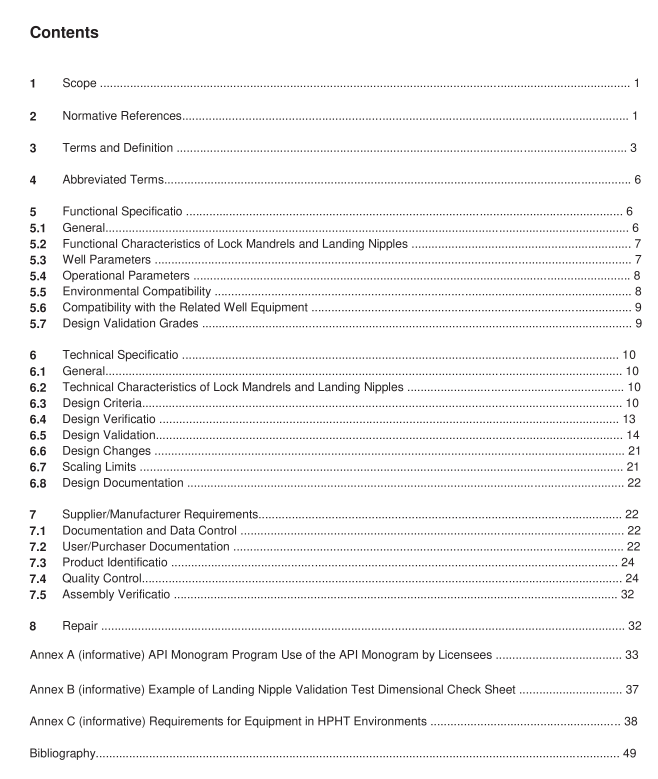API Spec 14L pdf download

API Spec 14L pdf download Lock Mandrels and Landing Nipples
6.3.1.2Lock mandrel and landing nipple equipment shall be manufactured to drawings and specifications thatare substantially the same as those used to manufacture the lock mandrel and landing nipple that has passedthe validation test.
6.3.1.3 Design Controls
6.3.1.3.1The supplier/manufacturer shall establish verified internal yield pressure, collapse pressure andminimum tensile strength, temperature limits, and rated working pressure, excluding end connections. Thesupplier/manufacturer shall identify the type 1 components of the product and the mode of stress.The supplier)manufacturer shall calculate the stress level in the type 1 component(s) based upon the maximum loads in thedesign input requirements to determine those components that are critically stressed.
The design shall take into account the effects of pressure containment and pressure-induced loads.Specializedconditions, such as pressure testing with temporary test plugs,shall also be considered.
6.3.1.3.2 Critically stressed components are those type 1 components that are stressed to 90 % or greater ofthe minimum design yield strength of the material.
6.3.1.3.3 The minimum material condition and minimum material yield strength shall be used in the calculations,which shall include effects of temperature.Metal mechanical properties derating shall be verified by a qualifiedperson and in accordance with:
a)industry recognized published data;
b) data established by the supplier/manufacturer; or
c)data provided by the material subsupplier.
NOTE ASME BPVC Section ll, Part D and APITR 6MET contain temperature derated tensile strengths for manymaterials.
6.3.1.4 Component and subassembly identification and interchangeability shall be required within each supplier’s/manufacturers size, type, and model, including working pressure rating of lock mandrel and landingnipple equipment. Additive dimensional tolerances of components shall be such that proper operation of the lockmandrel and landing nipple equipment is verified. This requirement applies to supplier/manufacturer-assembledequipment and to replacement components or subassemblies.
6.3.2 Materials
6.3.2.1 General
The supplier/manufacturer shall have documented specifications for all materials used. If the user/purchaser doesnot specify materials , the supplier/manufacturer shall select materials suitable for the functional specification.Common hardware items such as nuts, bolts, set screws, and spacers can be specified by reference to industrystandards or description.
NOTE See 7.4.4 for traceability requirements.
Material substitution, during equipment manufacture, is a temporary change to a BOM for a validated item.Material substitution shall not decrease the performance capabilities of the product and requires approval bya qualified person from the supplier/manufacturer. Sealing device materials shall not be substituted duringmanufacture.The manufacturer’s technical justification for each substitution shall be documented and thesubstituted material shall conform to the design, functional, and technical requirements of this specification. lncases where the user/purchaser specifies material(s) of construction, deviations from such material(s) shall alsorequire user/purchaser approval.
6.3.2.2 Metals
6.3.2.2.1 The supplier’s/manufacturer’s specifications shall defin
a)chemical composition limits;
b)heat treatment conditions;
c)mechanical property limits, as applicable:
1)tensile strength;
2)yield strength;
3)elongation;
4)hardness.
NOTE The method of manufacture (e.g.cast, hot worked, cold worked, etc.) may be important to specify to achieverequired physical properties.
6.3.2.2.2 The mechanical properties specified in 6.3.2.2.1 shall be verified by tests conducted on a representative material sample produced from the same heat, size, and heat treat lot of material. Mechanicaltesting shall be performed per 7.4.2.2.1 after all thermo-mechanical processing, with the exception of stress reliet.Mechanical testing is not required after stress-relieving, provided the stress relief is performed in accordance
with the manufacturer’s written requirements designed to ensure the material retains sufficien strength to meetdesign requirements. Material subsequently stress-relieved shall be hardness tested after processing to confirmcompliance with the hardness requirements of the supplier’s/manufacturer’s specifications
6.3.2.2.3 Each welded component shall be stress-relieved in accordance with the supplier’s/manufacturer’swritten specifications and, where applicable, in accordance with the ASME Boiler and Pressure vessel Code,Section lX.
6.3.2.3 Non-metals
The supplier/manufacturer shall have documented procedures, including acceptance criteria, for evaluations ortesting of sealing materials or other non-metals, to the limits for which the equipment is rated.Evaluations (ortests) shall verify the material used is suitable for use in the specific configuration, environment, and application.These evaluations shall include the combination of pressure, temperature, and the fluids compatible with theintended application.









